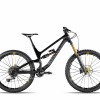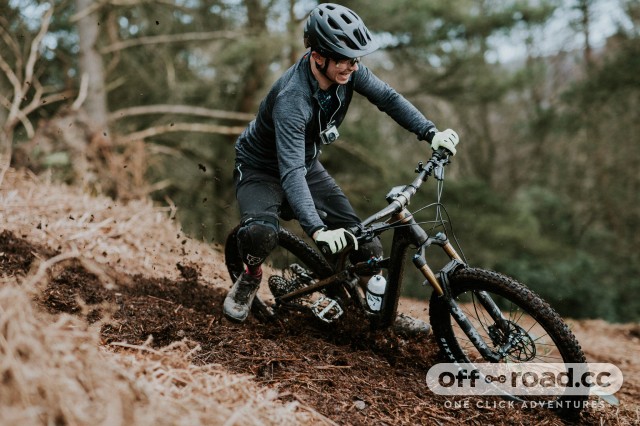First Ride: 2018 Canyon Spectral CF

After a solid day of thrashing Canyon's all-new 2018 Spectral CF in the Surrey Alps Hills, our first impressions are that the serious suspension and chassis tweaking has managed to improve further on what was already a superb value mid-travel trail bike.
- Buyer's guide to mountain bikes: everything you need to get the best bike for you
- Review: 2017 Canyon Spectral CF 8.0 EX - superb value all-carbon trail machine
- Video: The Dudes of Hazzard - Fellowship of the Party Ring
We've covered the updates to the Spectral range in-depth elsewhere, but to recap quickly, the new bike has had an awful lot of work done with both the overall frame design and the suspension kinematics in particular. The obvious bit is that despite travel remaining the same at 140mm at the rear and 150mm at the front, the shock now mounts to the top tube rather than near the bottom bracket junction.
That's allowed Canyon's designers to give it a more supple starting stroke paired with a more progressive ramp up towards the end of the travel. It's been taken in part from the theory behind Canyon's Sender downhill bike, which has three distinct phases within the travel; a supple initial stroke to overcome seal friction in the shock, a supportive mid-stroke to give good rider feedback in turns and when pumping plus an ending stroke that resists bottoming out The new top tube mounted shock also puts less stress on the frame and bearings, which should lead to a longer life for both.
The new design has also taken in a load feedback from their Enduro World Series racers and all-round good guys The Dudes of Hazzard. That's resulted in better bearing sealing - the Highlands of Scotland aren't great for bearing life - and also slightly more anti-squat in the suspension.
Anti-squat is basically how forces through the chain resist the action of the suspension compressing and it's an essential factor in making a bike pedal well. Too much anti-squat and the pedals will kick back as the suspension compresses, making for a rough ride. Too little and the bike's suspension will be more likely to compress as you pedal, making for an inefficient ride and a ride feel that's often described as 'soggy' or 'lazy'.
Enough tech, how does it ride?
Canyon furnished me with the second-from-top Spectral CF SL bike, which gets a full carbon fibre frame, 12spd SRAM X01 Eagle drivetrain and Factory series Fox DPS shock and 34 fork, along with some DT Swiss XMC 1200 Spline wheels with carbon rims. That'll set you back a not-insubstantial £4,499, but by the standards of high-end trail bikes, that's pretty damn reasonable for what you're getting.
Interestingly enough for an industry where every bike is lighter, longer and slacker, neither of those specs has really changed very much over the old bike. The weight is pretty much static, but that's because the Spectral now been bumped up to sit in Canyon's enduro category (number 4 out of a total of 5, if you're interested) which means it has to go through much more rigorous and abusive in-house testing.
When it comes geometry, Canyon's Senior Product Manager, Daniel Oster, said that while they're aware of a trend and desire in certain markets (take a bow, Britain) for substantially longer reach and much slacker head angles even for trail bikes, the feedback from their development riders and racers has been that they're pretty happy with how the bike currently is. That means that reach only grows 5mm to 460mm for a large frame and head angle drops half a degree to 66.5º, putting it pretty much exactly alongside mainstream 140-160mm travel peers.
All that means that leaping on board the new Spectral feels pretty much the same as the old one. At 5'8, I rode a large frame - I'm definitely one of those people that prefer more reach - and as with the old bike, that meant I found the headtube a bit tall. I prefer a lower front end than many riders I know, but it's worth being aware of if you intend to size up, as I did.
Anyway, on the first climb of the day, the new Spectral felt familiar in an entirely positive way. Certainly, in this spec, there's not much weight holding you back up the hills, with the slightly fatter 2.6" Maxxis rubber now fitted not making any appreciable difference to drag either. The old bike definitely felt quite a lot stiffer in the first part of the travel and while the new bike's suspension definitely doesn't feel quite as taut off the top when stomping on fireroad, it's certainly not a soggy, bobby nightmare by any means - in fact, the lack of chatter being passed through was noticeable in a positive way.
Perkier yet more planted
However, within the first few turns of the first descent, the changes in the rear end were massively noticeable. Compared to the old bike, the rear end was much more supple, keeping in contact with the ground with much less chatter. Some of that might be down to the slightly fatter tyres and the more supple Fox shock than the old, RockShox sprung bike I ride, but the bike was much more planted and I instantly had more faith in the back end.
Cue some tight, interlinked turns and the difference between the old and new bike are even more apparent. The new bike is much quicker to change direction, with the greater support in the middle of the travel allowing you to push the bike harder through corners and exit with more pace. It was also noticeable that the bike was happier to sit up and switch sides between turns, which Daniel explains is heavily down to the increased anti-squat, which gives the bike a much more lively feel in this situation as well as when you want to hop or loft it over roots.
It's these suspension tweaks that have made a huge difference to the overall character of the bike. It's both more planted and more playful, which is an encouragement to push harder and have more fun. One ride in one place really isn't enough to get to grips with a bike, but on first impressions, one of the best trail bikes out there has got even better.
Okay, so for my tastes I'd prefer a bit more frame reach across the range - having the reach of the large with the standover and head tube height of the medium would be ideal as far as I'm concerned - but that seems a bit princess and the pea when you consider the stonking all-around value you're getting. I'm especially keen to get my hands on one of the cheaper, aluminium framed Spectrals in the range, which look like they'll offer similar performance at nearly unbeatable value. Hopefully, we'll get our hand on one soon to do exactly that.
You can check out the rest of the range in full here anyway:


















